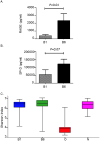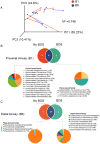Distal airway microbiome is associated with immunoregulatory myeloid cell responses in lung transplant recipients
- PMID: 28756121
- PMCID: PMC5893420
- DOI: 10.1016/j.healun.2017.07.007
Distal airway microbiome is associated with immunoregulatory myeloid cell responses in lung transplant recipients
Abstract
Background: Long-term survival of lung transplant recipients (LTRs) is limited by the occurrence of bronchiolitis obliterans syndrome (BOS). Recent evidence suggests a role for microbiome alterations in the occurrence of BOS, although the precise mechanisms are unclear. In this study we evaluated the relationship between the airway microbiome and distinct subsets of immunoregulatory myeloid-derived suppressor cells (MDSCs) in LTRs.
Methods: Bronchoalveolar lavage (BAL) and simultaneous oral wash and nasal swab samples were collected from adult LTRs. Microbial genomic DNA was isolated, 16S rRNA genes amplified using V4 primers, and polymerase chain reaction (PCR) products sequenced and analyzed. BAL MDSC subsets were enumerated using flow cytometry.
Results: The oral microbiome signature differs from that of the nasal, proximal and distal airway microbiomes, whereas the nasal microbiome is closer to the airway microbiome. Proximal and distal airway microbiome signatures of individual subjects are distinct. We identified phenotypic subsets of MDSCs in BAL, with a higher proportion of immunosuppressive MDSCs in the proximal airways, in contrast to a preponderance of pro-inflammatory MDSCs in distal airways. Relative abundance of distinct bacterial phyla in proximal and distal airways correlated with particular airway MDSCs. Expression of CCAAT/enhancer binding protein (C/EBP)-homologous protein (CHOP), an endoplasmic (ER) stress sensor, was increased in immunosuppressive MDSCs when compared with pro-inflammatory MDSCs.
Conclusions: The nasal microbiome closely resembles the microbiome of the proximal and distal airways in LTRs. The association of distinct microbial communities with airway MDSCs suggests a functional relationship between the local microbiome and MDSC phenotype, which may contribute to the pathogenesis of BOS.
Keywords: bronchiolitis obliterans syndrome; immunoregulation; lung microbiome; lung transplantation; myeloid-derived suppressor cells.
Copyright © 2017 International Society for the Heart and Lung Transplantation. Published by Elsevier Inc. All rights reserved.
Figures




References
-
- Annual Data Report of the US Organ Procurement and Transplantation Network Preface. Am J Transplant. 2014;14(1):5–7. - PubMed
-
- Burton CM, Carlsen J, Mortensen J, et al. Long-term survival after lung transplantation depends on development and severity of bronchiolitis obliterans syndrome. J Heart Lung Transplant. 2007;26:681–686. - PubMed
Grants and funding
LinkOut - more resources
Full Text Sources
Other Literature Sources
Research Materials

